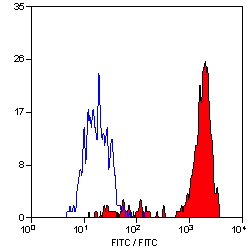Rat anti-Mouse EMR1 Monoclonal Antibody | anti-EMR1 antibody
EMR1 (EGF-like Module Containing Mucin-like Hormone Receptor-like 1, EMR1 Hormone Receptor, Cell Surface Glycoprotein EMR1, Cell Surface Glycoprotein F4/80, DD7A5-7, EGF-TM7, F4/80, Gpf480, Lymphocyte Antigen 71, Ly71, TM7LN3) (MaxLight 750)
Reactivity
Mouse
Applications
Flow Cytometry, Functional Assay, Immunohistochemistry, Immunoprecipitation, immunoassay, Radioimmunoassay, Western Blot
Purity
Purified by protein G affinity chromatography from tissue culture supernatant.
Synonyms
EMR1, Antibody; EMR1 (EGF-like Module Containing Mucin-like Hormone Receptor-like 1, EMR1 Hormone Receptor, Cell Surface Glycoprotein EMR1, Cell Surface Glycoprotein F4/80, DD7A5-7, EGF-TM7, F4/80, Gpf480, Lymphocyte Antigen 71, Ly71, TM7LN3) (MaxLight 750); EGF-like Module Receptor 1; F4/80 Antigen; anti-EMR1 antibody
Host
Rat
Reactivity
Mouse
Clonality
Monoclonal
Isotype
IgG2b
Clone Number
9E38
Specificity
Recognizes mouse F4/80.
Purity/Purification
Purified by protein G affinity chromatography from tissue culture supernatant.
Form/Format
Supplied as a liquid in PBS, pH 7.2. Labeled with MaxLight750.
Applicable Applications for anti-EMR1 antibody
Flow Cytometry (FC/FACS), Immunohistochemistry (IHC), Immunoprecipitation (IP), Radioimmunoassay (RIA), Western Blot (WB)
Immunogen
Thioglycollate stimulated peritoneal macrophages from C57/BL mice.
Conjugate
MaxLight750
Preparation and Storage
Store at 4 degree C. Do Not Freeze.
Application Data
(Staining of mouse peritoneal macrophages with RAT ANTI MOUSE F4/80 ANTIGEN: ALEXA 405)
Product Categories/Family for anti-EMR1 antibody
References
1. Austyn, J.M. and Gordon, S. (1981) F4/80, a monoclonal antibody directed specifically against the mouse macrophage. Eur. J. Immunol. 11: 805-815, 2. Hume, D.A., Perry, V.H., and Gordon, S. (1984) The Mononuclear Phagocyte System of the Mouse defined by Immunohistochemical Localisation of Antigen F4/80: Macrophages Associated with Epithelia. The Anatomical Record 210: 503-512, 3. Lee, S.H. et al. (1985) Quantitative analysis of total macrophage content in adult mouse tissues. Immunochemical studies with monoclonal antibody F4/80. J. Exp. Med. 161: 475-489, 4. Gordon, S. et al. (1992) Antigen markers of macrophage differentiation in murine tissues. Curr. Top. Micro. Immunol. 181: 1-37, 5. Warschkau, H. and Kiderlen, A.F. (1999) A monoclonal antibody directed against the murine macrophage surface molecule F4/80 modulates natural immune response to Listeria monocytogenes. J. Immunol.163: 3409-3416, 6. Lin, H. H.et al. (2005) The macrophage F4/80 receptor is required for the induction of antigen-specific efferent regulatory T cells in peripheral tolerance. J. Exp. Med. 201: 1615-1625, 7. Chan, R.J. et al. (2005) Human somatic PTPN11 mutations induce hematopoietic cell hypersensitivity to granulocyte-macrophage colony stimulating factor Blood. 105: 3737-3742, 8. F. X. Pizza et al. (2005) Neutrophils contribute to muscle injury and impair its resolution after lengthening contractions in mice J. Physiol. 562:899-913, 9. Metwali, A. et al (2004) Cutting Edge: Hemokinin Has Substance P-Like Function and Expression in Inflammation The Journal of Immunology, 172: 6528-6532, 10. Kathryn J Moore et al (2009) Divergent Responses to LPS and Bacteria in CD14-Deficient Murine Macrophages. The Journal of Immunology, 165: 4272-4280
Similar Products
Product Notes
The EMR1 (Catalog #AAA26842) is an Antibody produced from Rat and is intended for research purposes only. The product is available for immediate purchase. The EMR1 (EGF-like Module Containing Mucin-like Hormone Receptor-like 1, EMR1 Hormone Receptor, Cell Surface Glycoprotein EMR1, Cell Surface Glycoprotein F4/80, DD7A5-7, EGF-TM7, F4/80, Gpf480, Lymphocyte Antigen 71, Ly71, TM7LN3) (MaxLight 750) reacts with Mouse and may cross-react with other species as described in the data sheet. AAA Biotech's EMR1 can be used in a range of immunoassay formats including, but not limited to, Flow Cytometry (FC/FACS), Immunohistochemistry (IHC), Immunoprecipitation (IP), Radioimmunoassay (RIA), Western Blot (WB). Researchers should empirically determine the suitability of the EMR1 for an application not listed in the data sheet. Researchers commonly develop new applications and it is an integral, important part of the investigative research process. It is sometimes possible for the material contained within the vial of "EMR1, Monoclonal Antibody" to become dispersed throughout the inside of the vial, particularly around the seal of said vial, during shipment and storage. We always suggest centrifuging these vials to consolidate all of the liquid away from the lid and to the bottom of the vial prior to opening. Please be advised that certain products may require dry ice for shipping and that, if this is the case, an additional dry ice fee may also be required.Precautions
All products in the AAA Biotech catalog are strictly for research-use only, and are absolutely not suitable for use in any sort of medical, therapeutic, prophylactic, in-vivo, or diagnostic capacity. By purchasing a product from AAA Biotech, you are explicitly certifying that said products will be properly tested and used in line with industry standard. AAA Biotech and its authorized distribution partners reserve the right to refuse to fulfill any order if we have any indication that a purchaser may be intending to use a product outside of our accepted criteria.Disclaimer
Though we do strive to guarantee the information represented in this datasheet, AAA Biotech cannot be held responsible for any oversights or imprecisions. AAA Biotech reserves the right to adjust any aspect of this datasheet at any time and without notice. It is the responsibility of the customer to inform AAA Biotech of any product performance issues observed or experienced within 30 days of receipt of said product. To see additional details on this or any of our other policies, please see our Terms & Conditions page.Item has been added to Shopping Cart
If you are ready to order, navigate to Shopping Cart and get ready to checkout.


























